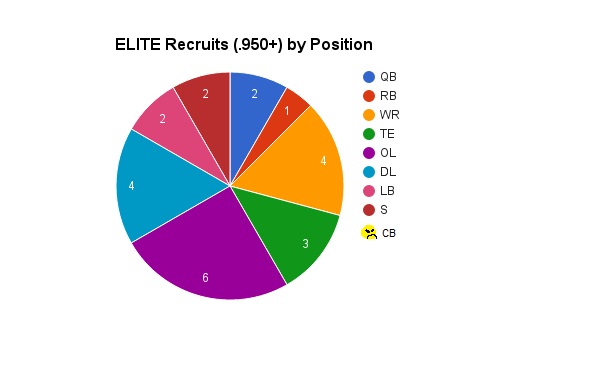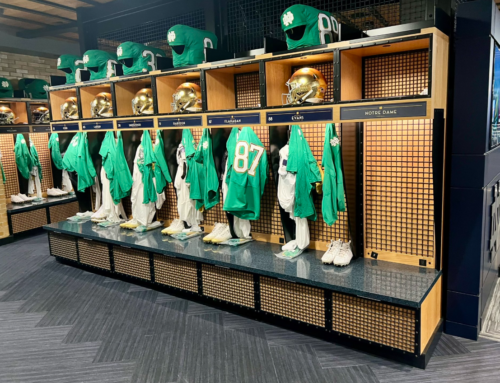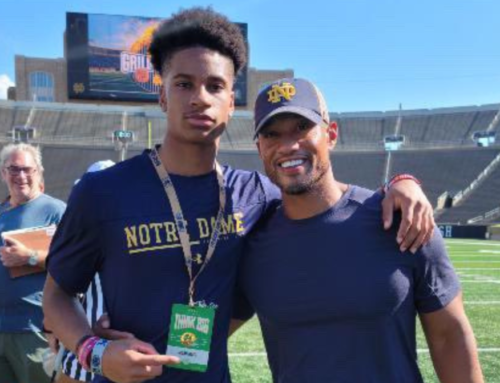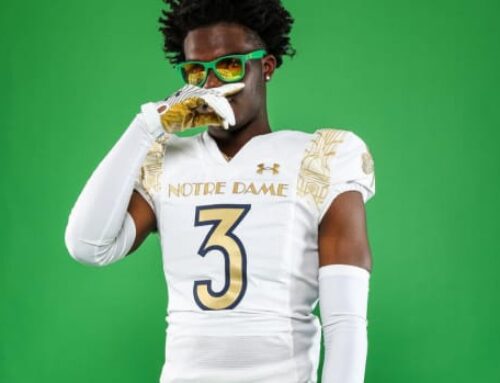Note: this article was written prior to the commitments of running back C.J. Holmes and offensive guard Robert Hainsey. Both now give the Irish offense 7 blue-chip players on offense for 2017.
*****
Brian Kelly isn’t in an enviable position with regards to recruiting. He’s proven over more than a half-decade at Notre Dame that he’s a good recruiter capable of bringing in steady classes hovering near the Top 15 nationally. Moreover, he’s proven he’s a smart recruiter–someone who has tweaked his strategies and excelled at finding under-the-radar recruits early in the process who fit well into the program culture.
The reason why this isn’t enviable is because, like his overall performance on the field, Kelly has teased just enough success with recruiting that the next logical step is to expect–even demand–better results. Today, I’m going to take a look at some macro-level recruiting centering heavily around Notre Dame’s ability to lure blue-chip prospects to South Bend.

Blue-chip recruits are defined as players with 0.890 Composite scores or greater. Also, I placed players where they made their impact on the field not necessarily what they were labeled as recruits, i.e. Prosise at running back & Onwualu at linebacker.
Put simply, recruiting on both sides of the ball mirror each other, defense has struggled more than offense, and there’s been a general decline overall since 2013 when it comes to blue-chip acquisitions.
This graph only shows part of the picture, though. The recent 2016 class might have had the same amount of blue-chips on each side of the ball but there were 4 more defensive recruits overall and the offense grabbed the bulk of the high-end ELITE talent.
There’s been a lot of criticism of defensive coordinator Brian VanGorder’s recruiting efforts yet while this trend seems to back up those worries it also seems to have begun prior to his arrival and we may be in the middle of a strategic change in the defensive recruiting plan from Notre Dame. More on this below.

It comes as a surprise to no one that Notre Dame recruits better on offense. Since 2010, the Irish have signed 14 more blue-chip players on offense, or nearly 2 more than defense per class.
An interesting fact is that the Irish have been much better at retaining blue-chip defensive talent. The above graph removes blue-chip players who transferred, were placed on medical scholarship, or who otherwise faced circumstances which prevented them from playing football at Notre Dame through their academic senior year. Players leaving early for the NFL are not removed, because generally, they were awesome.
Unbelievably, the Irish have only “lost” 3 of their blue-chip defenders since Kelly arrived: Aaron Lynch, Ishaq Williams, and Doug Randolph.
Conversely, the offensive has lost 7 total blue-chip players. Even then, a ridiculous 4 of those came from the 2012 class alone (Kiel, Neal, Mahone, Ferguson). In total, I was surprised to see higher retention rates here than I expected. Out of 92 blue-chips signed a full 82 have at least stuck with Notre Dame. Especially in recent years, the Irish have had a lot of lowly-rated kids transfer.

The odds show that the next defensive recruit for Notre Dame will not be a blue-chip prospect. Just over 45% overall and that’s with a non-factor like John Montelus getting credited to the defensive line right now.
One reason why its easier to recruit on offense is due to the talent available. A quick look at the current top 100 recruits for 2017 shows a 54 to 44 advantage for offense. Within the top 50 it’s a 31 to 18 advantage for the offense. I doubt that’s much of an outlier compared to year’s past.
Defensive line always comes up when talking about struggles with recruiting but look at Notre Dame’s success (or lack thereof) in the secondary. Part of that is the way rankings are skewed. A lot of high school kids gravitate towards playing receiver or running back instead of corner. Most years there are precious few 4 and 5-star safeties to choose from.
Yet, 2017 is awfully loaded at the safety position–26 blue-chippers compared to just 17 last year. Then again, look at the demographics. Out of the top 20 safeties, a total of 4 come from Florida, 3 from Texas, 2 from Georgia, and one each from Virginia, Tennessee, Louisiana, Pennsylvania, Ohio, Utah, Nevada, Arkansas, Mississippi, Arizona, and California. With the top 10 corners, 4 hail from Georgia, 3 from California, 2 from Florida, and 1 from Pennsylvania.
That’s 27 out of the country’s 30 best secondary recruits nowhere near Notre Dame’s Midwest-based historical base of power. As Brendan pointed out yesterday, Notre Dame is still in the process of working through demographic changes across the country. The Irish have their eyes set on Jaylen Kelly-Powell (#21 safety) and even he comes out of Michigan pipeline school Cass Tech in Detroit. The defensive line recruiting isn’t exactly easy either but a lot of people sleep on how difficult it is for Notre Dame to bring in quality secondary talent.

There have been 24 ELITE blue-chip recruits signed by Notre Dame since 2010 and 16 have come on the offensive side of the ball (update: Hainsey’s commitment makes it 17/25 ELITE talents on offense). Even worse, Nyles Morgan is the only defender in this graph from the past 4 recruiting cycles, including the half-filled 2017 class. This is why with the “losses” of the likes of Kiel, Neal, and Bryant (RIP) Notre Dame has been fine on offense–another couple ELITE recruits are coming in the next class.
You’ll notice there have been no ELITE corners since 2010 although Russell (.937), Luke (.932), Watkins (.923), and Crawford (.945) came close. Safety depth is even worse. Even with Shumate and Redfield adding 2 ELITE blue-chip talents the next highest-rated safety during the Kelly-era is Eilar Hardy (.914).

Here again is the crux of the problem stated above: Offense is out-pacing the defense, there’s room for improvement on defense, and in general the trend for both isn’t super encouraging. We probably shouldn’t worry at all about the offense though. As stated above, with the recent offensive additions that blue line is pointing back up.
What about the defense, though? How much better can it really get?
Like his predecessor, VanGorder has quickly earned the label as someone who isn’t just a bad recruiter but someone who doesn’t like recruiting. There’s almost always a 1:1 relationship in terms of defense performance : recruiting prowess through the eyes of fans and media but fair or not that’s the current stigma.
At this point we need to talk about player development and eye for talent. It’s pretty common for fans to desire a young, dashing, and bold recruiter at defensive recruiter. The list of those candidates seems ridiculously small, though. In some ways it’s just not a reality like it can be on offense. Bob Diaco seemed to be one of those guys as Irish recruiting sky-rocketed through 2013 but one year removed from a historic defensive performance Diaco’s No. 30 FEI ranked defense was deemed unworthy by plenty of folks, his schemes rendered far too simple, and he was chastised as too rigid in his evaluations while not caring enough about recruiting, as well.
VanGorder in some ways is the complete opposite with his complicated schemes and less rigidness in player profiles. It’s the latter concern that really interests me. The Irish can recruit better on defense but the brutal honest truth is that there probably isn’t a huge ceiling for sustained excellence.
Absent a handful of consecutive enormously dominant seasons does anyone think Notre Dame can recruit on defense averaging something like .920 per player over several seasons? Does anyone think a hot-shot young DC alone can boost the average up to that stratosphere?
Even the 2011 haul featuring the ELITE’S of Lynch, Ishaq, and Tuitt saw a significant drop-off in talent after those players–the aforementioned Hardy was the 4th highest rated defender of the class. The 2013 class saw 11 out of the 13 offensive recruits with .900 or better scores. That type of sprawling talent grabbing just isn’t realistic on defense, in my opinion. For example, there have only been 11 players with .900+ scores on defense for the 3 signed classes from 2014-16. The previous 3 cycles (2011-13) it was 15 defenders.
Whether VanGorder is still at Notre Dame past 2016 or not I think the altered focus on over-recruiting defense and purposely seeking out raw 3-stars early in the process is a smart move on the programs’ part, no matter who the DC remains. The demographics and culture surrounding the bulk of the nation’s elite defenders are not in Notre Dame’s favor right now. By necessity, Notre Dame’s defensive recruiting and development has to be closer to Michigan State’s than Alabama.
VanGorder may not be the right coach to develop that talent and I’ll admit I moan a little with every 3-star verbal. Nonetheless, the staff as a whole has proven to make shrewd decisions for the non-blue chip prospects and that can still set up a bright future with the right teaching.
Let’s hope this guy verbals to Notre Dame on Friday and gives the blue-chip rate a healthy boost.





“Unbelievably, the Irish have only “lost” 3 of their blue-chip defenders since Kelly arrived: Aaron Lynch, Ishaq Williams, and Doug Randolph.”
I’m guessing Vanderdoes wasnt included because he never made it to campus?
Haha yeah didn’t count him.
Vanderdoesn’t count, eh?
/punches self
To the Wheel of Pain with you, my friend.
/punches TGGS for not punching self hard enough
Great analysis. It is interesting that while 60% blue-chip rate has been shown to be “championship level recruiting” I wonder if there would be further analysis that bears out whether it matters if it is more offense or more defense or equal. We’ve been getting and staying above that 60% number but questions remain: within that 60% do we have enough ELITE players? And you’ve pointed out another way here: do we have enough blue-chips on defense?
I find the notion that taking raw 3-stars is the way to go in certain ways to fill out our roster given the circumstances very interesting (of course it doesn’t mean we don’t keep trying to recruit the blue-chips). I wonder how we could determine if that has been working. How many of our 3 stars (versus other people’s three stars) turn into “blue chip” type players? It isn’t enough that they are a starter because it could be the case they are a bad starter (even if they put up good numbers) – by bad starter i just mean they get exposed against the best competition on our schedule. We know that a higher percentage of 4-5 star players turn into really good players, but it isn’t out of the question with good scouting and good player development that any particular team could turn a higher percentage of 3 stars into really good players. There is some limited anecdotal evidence that makes me think ND does this. Think: N. Martin, Okwara, C. Brown, Farley, Schmidt, Martini – just to name some starters in the past couple of years.
Good follow-up question on developing good vs. bad starters from those projects. Because positions develop differently and have different coaches, they kind of need to be taken individually. When it comes to ND, the bogey man for fans seems to be pass rushers followed not far behind by safety. These are two spots where production and development have been hit hard not only by lack of elite prospects, but a lack of numbers in general (admittedly for various reasons – defections, suspensions, recruiting holes, etc.)
Looking at pass rushers, I’m kind of falling in line with Brian Driskell’s stance on the B&G podcast that if they aren’t going to be able to rely landing a few elite prospects, the answer is volume. This is where getting a number of those projects and coaching them up improves the chances of somebody hitting.
On a site whose name I can’t recall, I once posted a list of preseason All American DEs, and I believe even draftees from the previous draft at DE, along with their recruiting rankings coming into college. It was very interesting how many of them came into college as athletic projects, some even at different positions – basically Justin Tuck types – but who developed over time. I recall very few of them being immediate big time players. There were outlier 5 stars from programs like Ohio St., but the list included a surprising number of developed projects.
I think that’s where ND needs to improve, though by no means should they quit chasing the elite pass rushers. Even if they land them, it helps to have depth and guys who work with.
Sticking with pass rushers, I really feel like the hiring of Gilmore was a step up from Elston from a technician standpoint. In his time at Cincinnati, Gilmore’s DL contributed to numbers near the tops in the nation in terms of sacks, tackles for loss and turnovers produced and he did this with mostly projects – some of whom are kicking around the NFL. He also produced his share of disrupting players at Illinois and UNC.
Gilmore’s the wildcard here, and I don’t mean in terms of attracting and recruiting blue chips. I think he’s a guy that if they can get the raw material to work with can make things happen. Romeo Okwara as noticeably more disruptive in his one year with Gilmore. His sack numbers were improved and I think would have been better had he not spent as much time in zone coverage as he did. (That’s a whole other topic. Ugh) Hopefully we can see Gilmore do some things with young additions such as Daelin Hayes and Kaleed Kareem.
I think Gilmore could end up being Hiestand’s equivalent on the defensive line. Hiestand didn’t get whoever he wanted initially – he turned out Zack Martin, a couple of elite rushing offenses, and Ronnie Stanley*, and now seemingly every top OL recruit speaks glowingly of him. Gilmore had Kareem Martin at UNC, Akeem Spence and Whitney Mercilus at Illinois, Connor Barwin at Cincinnati… If you really want to go back, he had 3-time Pro Bowl safety Antoine Bethea when he was the DC at Howard. The guy knows how to get people to the league, just like Hiestand does.
Some of this year’s DE recruits, like Hunter Echols, have had really good things to say about him and his coaching style. Give him a season or two to show he can get guys drafted, and I guarantee we’ll be on the radar with more elite DE recruits.
* Speaking of which, watch what happens in the 2018 recruiting cycle after Hiestand produces his second consecutive top-ten draft pick.
How important is pass rush, really, in this era of HUNH offenses? Seems like if you can just get burnt less and win the efficiency chicken battle, that’s more important than having a guy with 10+ sacks per season.
Really great stuff.
Great write-up! Thanks!
This is probably way too much work but any chance we have similar info on Bama and fOSU? That way we could have a point of reference or two to compare all the above graphs? In any case, I appreciate all your hard work.
Damn you guys are good. You’re itching my sports and intellect sides of the brain at the same time. Stop.
Can’t stop, won’t stop.
“a non-factor like John Montelus”
This is true, and it make me sad. John Montelus has the best nickname on the team. I wish we could use it more.
Pretty big bust factor with Montelus, unfortunately.
He was the No. 141 overall player in the 2013 class and may never take an important snap for the Irish.
[…] week we looked at the blue-chip rate at Notre Dame since 2010. The only tight end not to meet the blue-chip requirement was Jacob Matuka, recently […]